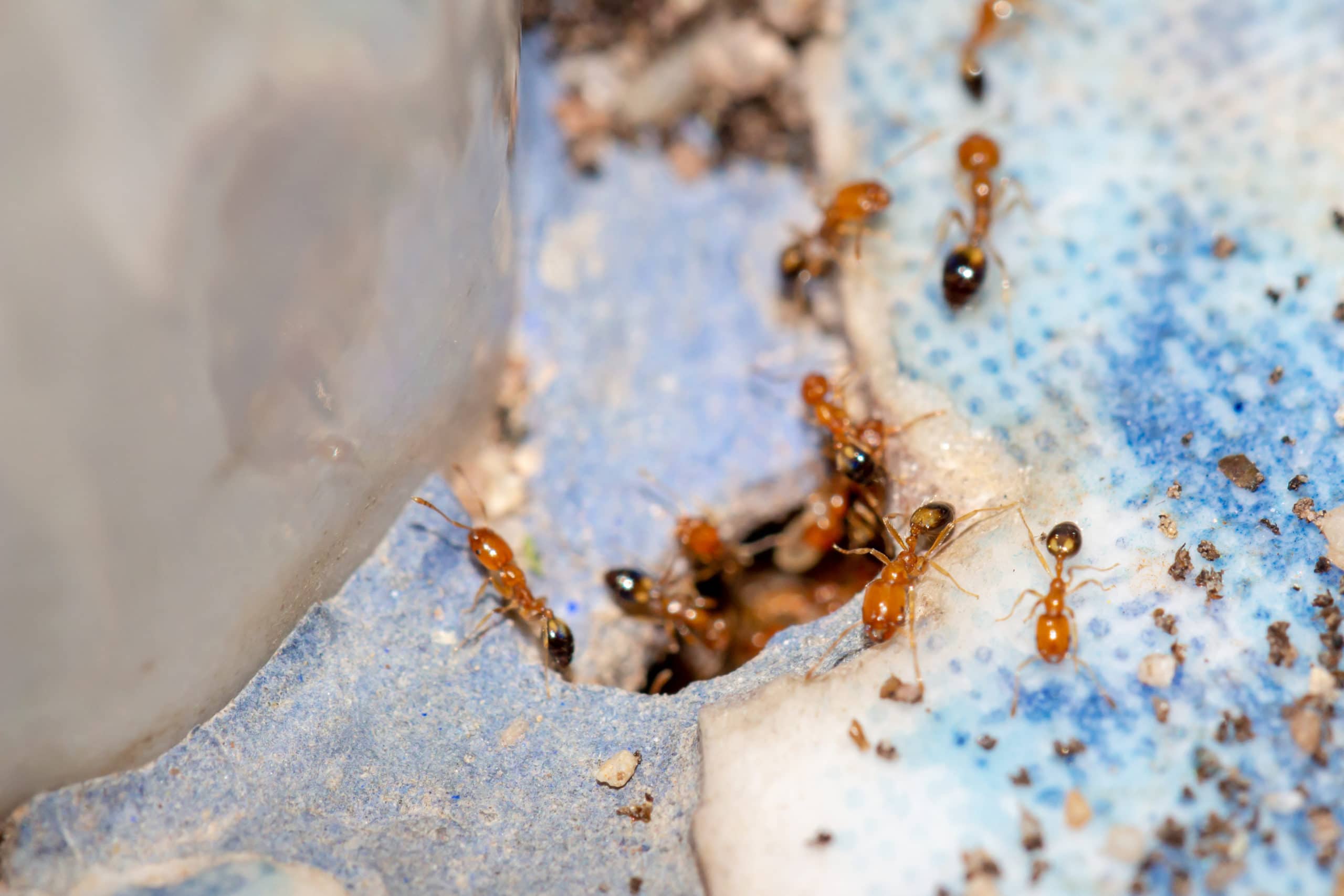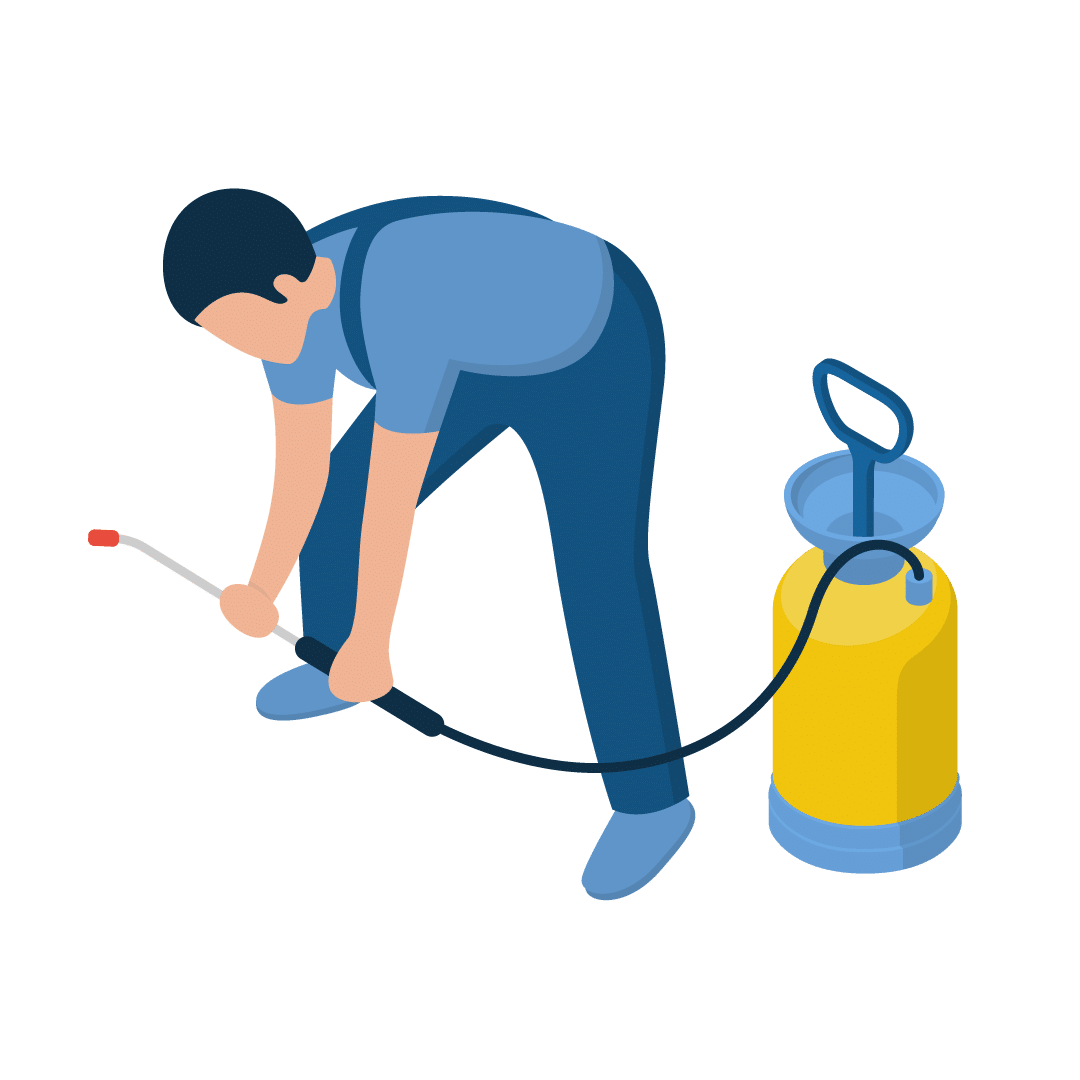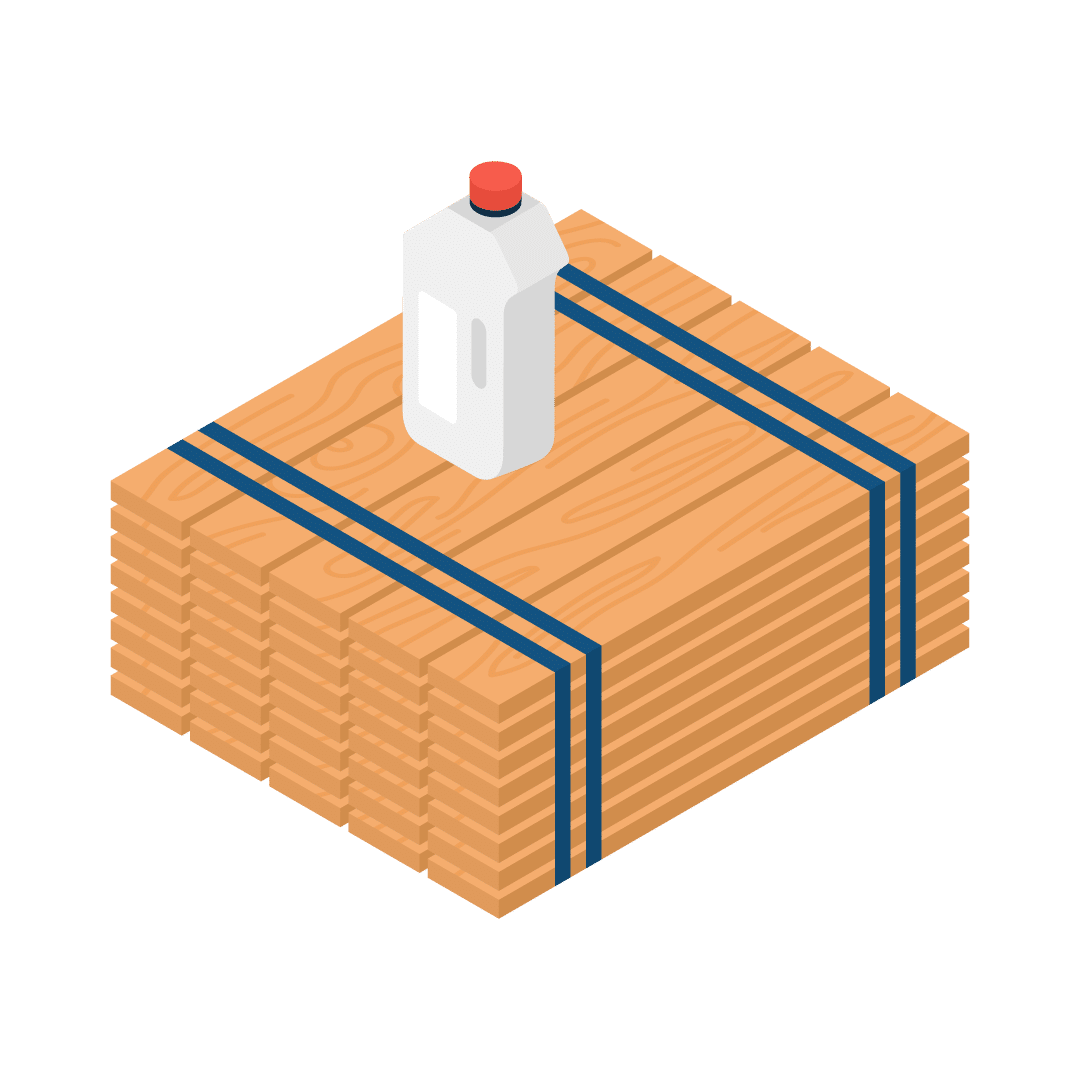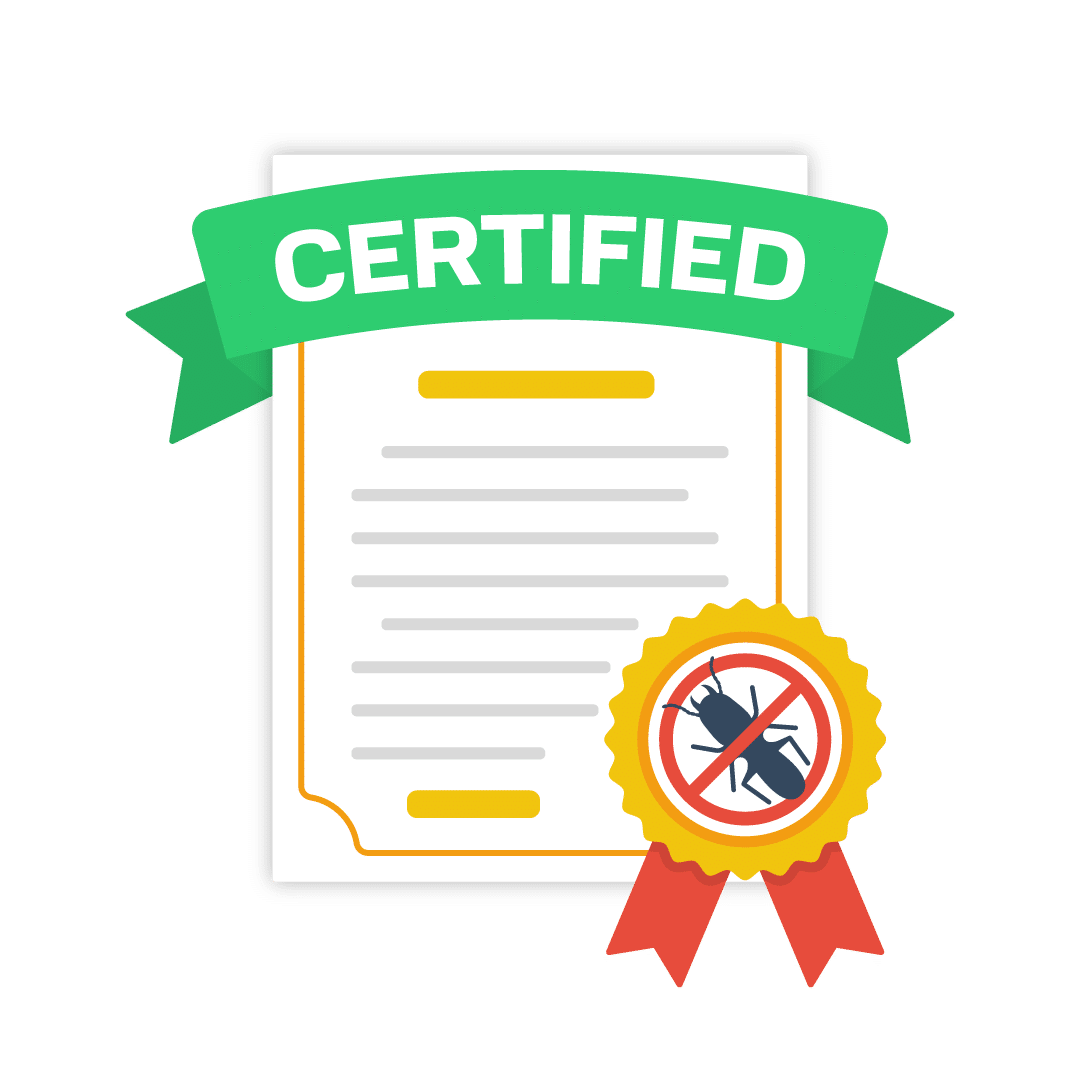TERMITE TREATMENT:
A COST & CONSUMER GUIDE
Every year, termites are notorious for causing more than $5 billion in property damage, according to the National Pest Management Association. Some of you might be thinking: it's no big deal, my insurance must cover it– but the thing is, most homeowners' policies don't typically cover these costs. It's why being vigilant about regular termite treatment for your household is always ideal.
AVERAGE COST OF TERMITE TREATMENT
$300 - $1,250
COST DEPENDING ON SIZE (PER LINEAR FOOT)
$4 - $22
If your termite control problem is not handled in time, these unwanted pests may cause extensive damage and cost thousands of dollars on repairs. Not to mention, it also poses several potential health risks. Unfortunately, a termite problem in your home can remain undetected for many years before you discover the severity of the damage. Avoid being in such a disastrous situation by considering regular termite control options or schedule annual inspections.
With several different termite treatment types, choosing the best one for your home needs considers the kind of termite and other related factors, which we'll discuss in detail below. Now, let's take a closer look at everything you need to know about termite treatment and its expected average costs.
What is a Termite Infestation?
Considerably the worst nightmare for many home and property owners, a termite infestation is nothing but a headache. These tiny insects form colonies that gnaw on your house’s physical structures.

They measure between a quarter to half an inch, although some are exactly one inch in length. A colony of hungry termites is powerful enough to eat away your home structures around the clock, consuming more than 6.7 kilograms of wood in just a week.
In particular, they will feast on the wooden support beams or your walls. If that isn’t burdensome enough, they also eat through plaster, insulation, and metal siding material. The scope of the infestation can include flooring, furniture, ceilings, and cabinetry.
Termites infest different areas in the country, and they are dubbed as the number 1 wood-destroying pests nationwide. The most common type is subterranean termites, which feed on decayed plant materials such as wood. Many homeowners consider termite preventative measures such as soil treatment with pesticide, thick barriers, or bait and monitoring systems to protect your property.
Possible Causes for Termite Infestation
Let’s first discuss the common reasons why termites are drawn into your home.
There are different causes behind potential termite activity. For instance, the location of your home could be a contributing factor. If you live in areas with warm weather and constant humidity, brace yourself for possible termite infestation.
Plenty of moisture inside your home can attract termite activity. It can be in the form of leaking pipes, poor drainage, and insufficient ventilation.
Moisture problems may also arise if you bump into plumbing or septic system-related issues. Moisture-rich areas can cause termites to thrive. In particular, damp wood and subterranean termites are attracted to environments with high humidity. It’s best always to keep the areas in your home dry. Ensure that your house is up-to-date with the proper ventilation, plumbing repairs, and inspection. Doing so will keep the termites and other unwanted pests out.
If you live in an area with warm weather all year round and get wet in the monsoon season, your house will, unfortunately, be more prone to termite activity.
Simply put, the hot, wet local climate puts your home at more risk of termite infestation. In particular, if you live in Arizona, it’s best to brace yourself for several active termite species and other pests. It’s one common predicament of homeowners in the area.
Existing cracks Plenty of moisture inside your home can attract termite activity. It can be in the form of leaking pipes, poor drainage, and insufficient ventilation.
Moisture problems may also arise if you bump into plumbing or septic system-related issues, fissures, or gaps in the home serves as free entry for termites. The cracks in your doors and windows may enable pests to make their way inside the house quickly. Different termite species may form colonies in the long run. Concrete foundations, in particular, serve as an attractive nesting ground for termites. The area is moist and away from shade– these insects may turn it into their home inside your home. Regardless, termites will thrive inside your house even if you do not have a concrete slab. The cracks and other entry points will suffice already. Hence, ensure to have any gaps filled as soon as possible.
One of the easiest ways to determine termite activity is to check the areas of your home with damaged wooden structures. Subterranean termites, in particular, are known to move through wood. They gnaw the inner parts and even leave evident markings.
Your home’s damaged wooden structures suggest possible termite infestation. If the wood crumbles upon touching it, you may need to assess it by a professional pest inspection service. (Related: Selecting The Right Type Of Wood For Your Pergola) While there’s nothing major to do to your home’s wooden structures, best keep any discarded wood away: firewood, branches, untreated mulch, and the like. These are all very attractive to termites.
Average Costs of Termite Treatment
On average, termite treatment will cost you somewhere between $300 and $1,250. The total costs will heavily depend on the treatment type, home size, scope of the infestation– where you may shell out approximately $4 to $22 per linear foot.
Keep in mind that addressing your termite troubles will only cost you more in the long run. Hence, the moment you suspect any termite activity, have a professional visit your home and check for confirmation. Doing so will let you conduct treatment as soon as possible. With several local exterminators near you, it’s best to compare prices and services to help you get the most bang out of your buck.
Factors that Increase Costs of Termite Treatment
When setting a budget for termite treatment, it is ideal to consider the additional expenses incurred. It includes the specific termite type, extent of the infestation, and further treatment to avoid reappearance.
Let's take a closer look at some of the common factors that increase the total costs of your termite control project:
In the United States, there are three common types of termites: damp wood, dry wood, and subterranean termites. These insects can form colonies that may cause extensive, severe damage to your home over time. General removal services are priced from $295 to $3,400, depending on the termite type.
Refer to the table below for a quick overview of the different termites, average treatment costs, and the best treatment type to get rid of them effectively.
Termite Type | Average Costs | Best Treatment Type |
|---|---|---|
Subterranean Termites | $303 - $1,215 | Soil Baiting, Chemical Treatment |
Dampwood Termites | $303 - $1,215 | Moisture Reduction, Termiticide Usage |
Drywood Termites | $303 to $1,215 $3,375 (Larger Colonies) | Bait Placing, Chemical termiticides, or chemical Soil Baiting, Chemical Treatment foam/gel. House Tenting for larger colonies |

Subterranean Termites
Considered the most destructive termite type, whole home treatment for subterranean termites might cost around $303 to $1,215 and up to $2,500 on average. These termites are notorious for building massive connections underground, even forming mud tunnels and thriving soil. The best way to get rid of subterranean termites is to place baits in the ground, but chemical treatment is also commonly used.

Dampwood Termites
Dampwood termites depend on moist wood to thrive in your home. If your house has high humidity levels and poor moisture control– this will serve as an invitation for termite activity. Dampwood termite control costs are similar to dry wood, from $303 to $1,215. To effectively deal with damp wood termites, your best option is to reduce home moisture and apply termiticide.

Drywood Termites
This termite type likes to eat decayed wood in support joints. They also require less moisture than damp wood termites and do not thrive in the soil like their Subterranean counterparts. Treatment for dry wood termites will cost you around $303 to $1,215. Larger colonies may require house tenting, ranging from $1,200 to $2,500 or more. Effective treatment types include bait placing, chemical termiticides, or chemical foam/gel.
The scope of your home's termite infestation will influence the total termite treatment expenses. Some telling signs of termite activity are as follows:
Visible Termite Swarms
The Appearance of Water Damage
Maze-like Designs in Wooden Structures
Hollow-sounding Timber
Buckling Ceilings or Walls
Quiet Chewing Noises
Extensive termite damage may put your house's structural integrity at risk, with ceilings and floors possibly collapsing at some point. Even though the infestation does not heavily affect the structural foundations yet, the condition of your home will get worse with ruined furniture, floors, carpets, and walls. Expect to spend up to $1,420 on framing repair, $2,570 on attic insulation installation, and $8,100 on crawl space cleaning.
Some termites will also feast on the paper lining of your drywall, and repairing such damage will cost you at least $680. If you notice any sign of possible termites infestation— contact a professional exterminator for immediate assessment. Choose to take action before the extent of the damage worsens.
Most professionals will consider the size of your home when it comes to calculating termite treatment costs. Hence, there's no all-purpose pricing for this aspect.
You can expect a whole-house termite treatment to reach $3,380, while limited applications will cost you approximately $300 to $1,240.
The specific termite treatment type for your home will be unique. Keep in mind that a particular plan may prove effective to one household, but it doesn’t automatically mean it’ll also be the best option for you. With that in mind, your termite treatment method will affect the total costs accordingly. A professional pest control company can help you determine the best choice depending on the termite type, the severity of the damage, and other factors.
Let’s take a closer look at the different types of termite treatment services and their average costs, as shown in the table below.
Treatment Type | Average Costs |
|---|---|
Termite Fumigation | $1,620 to $3,400 $2,980 to $5,130 (Larger Homes) |
Tenting and Heat Treatments | $1,080 to $3,780 |
Termite Micro Treatment | $1,552 |
Liquid-Soil Termiticides | $270 to $1,215 |
Termite Baits | $3,375 to $4,725 |
Building Materials with Termiticides | $405 and $675 |
Termite Barriers | $2,025 to $6,750 |
Your termite treatment spending will be priced depending on the best treatment approach for your needs. The frequency may also be another contributing factor in the total costs– depending on the assessment of professionals.

One effective way to deal with termites is to tent your entire house before using toxic fumes to obliterate the presence of these pests. Standard termite fumigation for a classic 1,250-square foot house will cost you from $1,620 to $3,400. Meanwhile, it will range from $2,980 to $5,130 for a larger 2,500-square foot house. Since this method utilizes harmful gas, you may need to vacate your home for several days (2 to 5 days) together with your pets and house plants.
Notably, this treatment approach is ideal if you have a dry wood termite infestation. It can be relatively more expensive than other extermination methods, but the process is almost foolproof that leaves no room for mistakes. After unsealing the home, experts will take an air sample to ensure the air in your home is no longer hazardous. It is essential to work with a reliable professional exterminating company for this process to ensure your safety. They are trained to follow intricate safety precautions: ensuring no entry in the home amid the fumigation and putting up visible warning signs around the area.

If you're keen on selecting an environment-friendly method to remove termites in your home, the good news is: heat treatment is an organic and chemical-free process. This approach has a similar concept with termite fumigation, where experts will contain your home with tented tarpaulins. With the use of hot air, the temperature is raised to 150 degrees Fahrenheit. Termites are not expected to survive this condition. Expect termite heat treatment to cost you between $1,080 to $3,780 on average.
Generally, the process takes about eight hours to one day to complete. From the name itself, blowers will create extreme heat to eliminate termites effectively. It is imperative to secure precious items in your household before the treatment– as they may be at risk of damage. It includes electronics, artwork, and the like.

Non-chemical electro-gun? Microwave system? These may sound a little too technical, but this termite treatment approach utilizes its power to remove the pests in your home. A standard option is to leave chemical termiticides in a controlled indoor space infested with the termites. Usually, professionals drill holes directly into the area to distribute the chemicals. If you consider a chemical-free approach, your contractor will apply the electro-gun or microwave straight into the area.
This treatment type is best for small-scale infestations, which may cost you up to $1,552.

If you want a long-lasting termite treatment method that can protect your home for up to five years, you might benefit the most from using liquid soil termiticides. It costs $270 to $1,215 on average. Do note that this approach isn’t as simple as the other options. First, you will need to dig a trench (6x6 inches) in the surrounding areas before applying the liquid treatment extensively. There should be no gaps before you fill in the trench. As previously mentioned, termites may crawl their way in if there are any cracks.
Any termite that dares to pass through and come into contact with the treated soil will have no chance of survival. A more straightforward method of application would be through the use of a sprayer.

Baiting is another method to control termite activity on your property. It is done by placing bait stations in strategic locations around the home, which may cost you up to $3,375 to $4,725, including annual servicing and monitoring. Typically, baits include potent ingredients that can gradually eradicate the termites and their colony. Although this is a relatively powerful method, you will need a bit of waiting for it to take effect. It's best to wait for 30 days or one month to see the results.
Accordingly, you will also need to monitor the stations regularly to ensure you're not running out of bait.

Before you even proceed with your property's construction project, you can opt to mix building materials with termiticides as a preventive measure against termite infestations. It will cost you anywhere between $405 and $675 per structure. If you have lumber material, you can have it treated with a termite-repellent concentrated solution. You may also opt to apply the chemicals anywhere the foundation meets the ground for soil treatment.
Other naturally termite-resistant materials you can consider are concrete, metal, and certain wood types.

Lastly, you can put up material barriers to defend your home from termite infestation. These are usually installed together with your house's foundation structure, as simple physical barriers or materials with termiticide. It is one practical solution to keep termites out, and it may cost you somewhere between $2,025 to $6,750.You can choose several materials, such as mesh barriers, which are typically made of durable and almost impenetrable stainless steel.
Another option is aggregate barriers composed of sand or rock particles or plastic barriers commonly used around service and utility pipes.
You will need an initial termite inspection done by a licensed exterminator to assess any termite infestation on your property. This service ranges from $92 to $513 on average. Passing this test is crucial for the first property owners. Fortunately, several termite control companies offer an initial inspection that's free of charge. Contractors usually check areas such as the basement, crawl space, corners, and inside cabinets.
The surrounding ground will also be checked, as well as the areas around the home's foundation. Keep in mind that a colony of termites could be living underground.
Before you stress over the extent of infestation in your property, you can always keep a close eye on any potential termite activity and take immediate action. For one, you can install termite monitoring stations around your home. These small receptacles help you check for active termite presence. It costs around $75, with the bait priced at $250 for a box of six.
Your contractor will typically check the monitoring stations every month. If it detects termite activity, the system is treated with insecticide that gradually prevents termites from reaching maturity.
Simply put, the longer the infestation remains unresolved– the more repair you'll need to do to make up for the damages. It would add up to a significant sum to your total termite treatment expenses.
Termites travel and form tunnels under your house's foundation. They can cause the primary wood frames to collapse and deteriorate. If your current foundation quality is poor, you may need to increase your budget for repairs some more. Doing so will ensure the structural integrity and safety of your household.
The thing is, termites can reappear even after treatment is complete. It's not because of inefficient services– but such is the nature of pest infestations. These insects grow massive colonies in no time. It's challenging to make sure they won't come back ever again.
In general, most termite control treatments last for a good five years. Beyond that, these pests can make a comeback in your home. Although setting up a monitoring station can help you keep a close eye on termite activity, their reappearance may need you to spend on treatment costs again. Depending on your local pest control company, your contractor may offer you significant discounts on your following services if you have been a loyal customer in the past.
As the adage goes, prevention is better than cure. Save yourself from termite infestation headaches by preventing any chances for their survival.
Here are some popular thermite prevention methods to consider including in your treatment plan:
You can think of a termite bond as a warranty for standard treatment– much like a maintenance contract. It costs between $680 to $2,700.
Most protection plans are tailored to the type of treatment you availed. In most cases, a professional contractor will regularly visit the property for termite activity inspection. The company will provide treatment accordingly as soon as termites are discovered. Accordingly, they can offer you a customized termite prevention plan to decrease the risk of future infestations. Do note that this may be uncontrollable for some homeowners living in termite-conducive areas, though. Since a bond covers you, you won't have to worry about paying additional expenses. It will give you extra protection against unwanted termite infestation.
Termite repellent expenses are similar to standard treatment costs, ranging from $305 to $3,400. There are several approaches to applying the treatment.
However, if you want to save time, it will be a lot quicker if your contractor sprays the chemical termiticides on the soil before the foundation installation. Some professionals may choose to apply the chemicals onto the structure before installing the drywall. Other standard methods include termite repellent chemicals (like Permethrin) with the paint mixture, floor polish, or wallpaper adhesive. Sometimes, it is mixed with concrete for frame foundations.
Common Signs of Termite Trouble
Many homeowners discover termite activity in their homes a little too late– just when extensive damage has been done.
Unfortunately, these insects can thrive on your property while undetected. It includes notorious dry wood termites feasting on deep, wooden structures or subterranean termites forming underground colonies. If you want to save yourself from dealing with the headache of termite infestation damage, be wary of the warning signs as early as possible. Here are some common signs of potential termite activity:
Perhaps the most obvious way to recognize termite activity in your home is to detect visible evidence immediately. It includes the following:
Drywall Discoloration
Peeling paint
Small, pinpoint holes in drywall
Loosened Tiles
Squeaky Floorboards
Damaged Wood
Maze-like patterns in pieces of furniture
Mud tubes in your home’s foundation
Galleries or tunnels in the wood
Frass (Termite Droppings)
Another key indicator is the sight of swarmers or flying termites. They usually emerge from nests in large groups. Depending on the species type, some may be more active at night and quickly captivated by any light source. Meanwhile, there are termite species that can also swarm in broad daylight.
It is your responsibility to recognize the early signs of termite activity and seek pest control services in the early stages of infestation. Doing so will help avoid breaking the bank over termite damage control.
Since termites feast on wooden structures by gnawing on them from the inside out, one way to monitor the condition of your house’s foundation is to determine the sound produced by wood. If you suspect an area that termites infest, it’s best to do a sound test accordingly.
You can use the back end of a solid tool to hit the wood, and its sound may pinpoint the extent of the damage. For your reference, undamaged wooden structures give off a deep, rich sound. Hollow wood affected by termite damage tends to have a high pitch sound.
Some homeowners find it confusing to distinguish termites from other pests, such as ants. A good reference point is to observe their color– as termites tend to have a lighter shade. In particular, termites take on a cream-colored hue, and their bodies appear to be translucent. These insects measure no longer than a few eighths of an inch.
Termites have a distinct body shape as well. They take on a broader body without a definite waist between the abdomen and thorax. A long, straight antenna is also observable.
Another clear indicator of termite infestation is a constant clicking noise. Termites are active and busy. These insects work around the clock when building tunnels and getting their resources– such as cellulose in wood. Although the movement of one termite doesn’t create noticeable noise, with hundreds of them in a colony, the sounds begin to accumulate.
Perhaps the most distinguishable is the warning sounds from termites, in which they warn their colony of potential danger. They give off a clicking sound in the process as they bang their heads against the wooden structures. So, if you notice a continuous chorus of clicks even when the entire household is quiet– it may suggest possible termite activity within your walls, floors, or cabinetry. Place your ear close to any termite-infested wooden structure, and you may just hear them munching away.
When termites feed on timber, their mud or excrement tends to trap heat and moisture, creating a more protective environment. Common aftermath includes swelled timber and warped wooden structures (such as stiff windows and deformed doors). It will make it more challenging to open termite-infested doors and windows at ease.
Benefits of Hiring a Professional Termite Control Company
Although it is tempting to save on professional service expenses by opting for DIY termite treatment, this could potentially be ineffective in solving the root problem. There are several readily accessible termite baits and termiticides you can purchase at your local store. However, they are better considered as a preventative measure instead of a complete treatment for termite infestation.
If you’re dealing with an active termite infestation, it’s best to consult a local pest control company for assistance. It helps you determine the extent of the damage and do repairs accordingly. With their expertise, they can also help you put preventative measures in place.
There’s nothing like having total peace of mind over guaranteed termite removal. Your local pest control company can offer you a better guarantee on all of the work involved. Should termites make a reappearance shortly after completed treatment or a colony has been proven to be incompletely eradicated, a team of experts is likely to revisit your property to make sure everything’s according to plan. In contrast, doing a DIY termite treatment project increases the likelihood of insufficient pest eradication. You may only put your home and your safety at risk in the process. As a result, you will need to pay more than you typically would if you went ahead with professional services in the first place. Giving protection to your home is a significant investment. Availing the services of a termite professional helps you deal with the active infestation efficiently and quickly. Say goodbye to these house pests in no time! Practically speaking, devote some time to request estimates from several termite control companies before choosing a particular treatment service. Ideally, your chosen company will offer a written guarantee to ensure you are still covered in the event of unsuccessful treatment.
If you do not have ample free time to do termite control treatment on your own, you better leave it in the hands of professionals. You can count on them to efficiently remove any termites in your property as quickly as possible. Remember that termites do not take breaks and will continuously feast on your home’s wooden structures around the clock. The longer you put off dealing with the problem head-on, the more damage repair you’ll need to do. These pests will continuously deface your property until you take fast action. Fortunately, a professional pest control company has the right tools and knowledge to eradicate any thriving termite colony swiftly.
Several homeowners tend to overlook telling signs of termite activity simply because they are unaware of it or lack experience in pest control. That said, it’s ideal for an expert to handle the termite eradication process for your property. They have extensive experience dealing with these insects, combined with adequate knowledge to get rid of them properly. It is also tricky to cover every corner of your home, including below the floors and inside the walls. Experts can handle this very painstaking task for your convenience.
If you have a beautiful lawn or landscape at home– they may be at risk of damage, especially if you’re spraying chemicals all over your property. Termiticides and termite-repellent chemicals may damage your plants and other greenery. Accordingly, a DIY pest control project will only heighten that risk. A professional termite control company is trained in the proper handling of chemical treatment. You can count on them to ensure your plants will be unharmed throughout the entire process.
Termite-repellent chemical agents are not only hazardous to unwanted pests. If handled inappropriately, they may also put you and your family at risk. For instance, they can cause allergic reactions or skin irritations to susceptible chemicals. Save yourself from worrying about the harmful side effects of these potent chemicals. Leave the treatment process to the professionals who are capable of delivering safe results. It’s one way to protect your loved ones from improper termiticide exposure– which may only do more harm than good. After a thorough assessment, they can recommend the most effective treatment that works best for your home and deal with the infestation safely. These professionals are trained to use and apply these chemical agents properly. Some companies also tend to go with eco-friendly products to avoid giving off negative impacts to the environment.
The average expenses for professional termite control services can be a hefty sum. However, doing so offers you a great ROI in the long run. Think of how much money you end up spending on recurring home repairs and the required frequency of the treatment. It may only accumulate the more prolonged the termite infestation goes undiagnosed. A professional termite control service can help you diagnose the root problem, eliminate all active termites in your home, and offer preventative measures to avoid their recurrence. Trust us– what you will pay for professional pest control services will be cheaper than repairing extensive damage brought by termite infestation.
Checklist in Choosing a Reliable Pest Control Firm
Here are some tips to consider in selecting a trusted pest control company:




Termite Treatment: Frequently Asked Questions (FAQs)
On a rough estimate, termite treatments may last up to 5 years. Remember that there are many treatments available and factors that help determine its longevity, such as:
The most popular and effective type of treatment is the liquid-soil treatment. Water-diluted termiticide is applied to destroy a colony of termites in a fast and easy way. Meanwhile, the baiting method may take more time before the termites can locate the poisonous bait and bring it to their colony. It gives them some time to cause more damage before getting eliminated possibly.
The length of the treatment process may depend on the size of your home or building. However, most pest control professionals can still complete the treatment for about a day.
Ideally, have your property assessed for termite inspection at least once a year. Doing so will minimize the damage to your home after detecting termite presence as early as possible.
Generally, using chemical agents to deal with termite infestation will be the most cost-effective option. It will cost you around $4 to $22 per linear foot on average. Your professional termite control company will use a combination of pest-repellent repellents and termiticides depending on the termite type, severity of the infestation, and other determining factors.
Unfortunately, most insurance plans do not include termite infestation coverage. With that in mind, it’s best to conduct a regular professional inspection of your property. Doing so will help you detect any termite activity and deal with the problem before it leads to extensive damage and costly repairs.
Conclusion
It is crucial to deal with termite infestations before things get out of control. Given that the treatment process may use various hazardous chemical agents, it’s better to hire a certified pest control professional for the job. You can count on professionals to formulate a comprehensive termite control solution for your unique needs – while giving crucial consideration to your budget and the most effective treatment method for your home situation.
With their expert advice, you can also give your home solid protection against future infestations!
